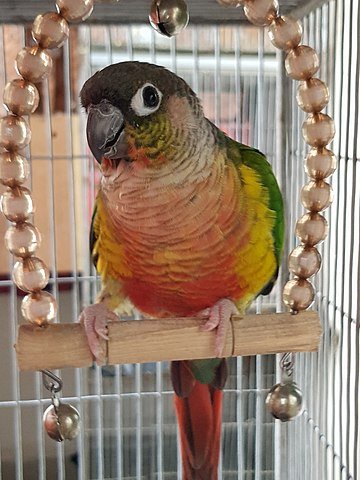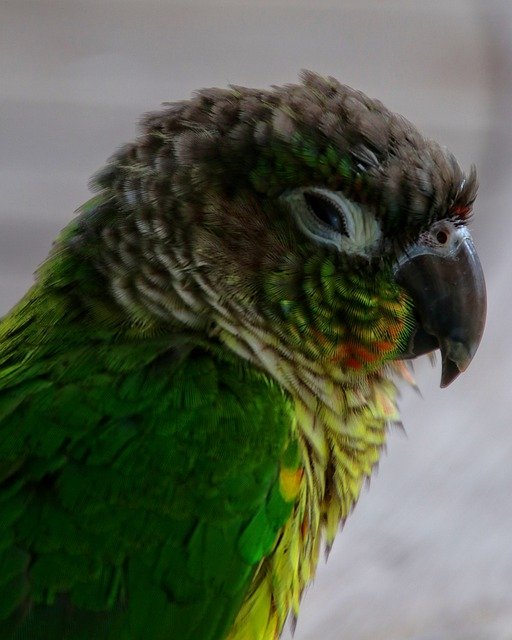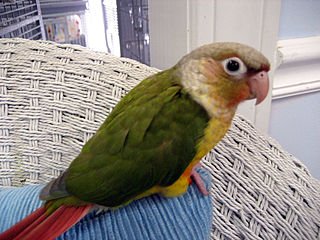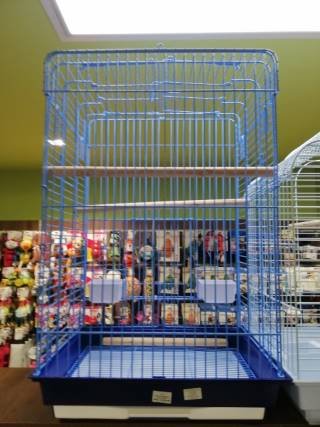One of the smallest conures, Green Cheek Conures, is loved among parrot lovers for various reasons. You would possibly have already got a green cheek conure with you or are planning to get one, which made you click on this article. The reason being knowing their dietary requirements before you adopt them. Unlike other conures, green cheek conures’ diet plan includes several different foods and flavors. It’s vital to understand what should be offered to them beforehand.
In this article, each aspect of a green cheek conure diet has been detailed. Let’s get started.
Green Cheek Conure Diet
Green cheek conures’ best diet must be filled with minerals and nutrients. They need to be served a diet full of calcium, minerals, amino acids, essential oils, and other nutrients. Such a healthy diet must contain balanced foods, fresh vegetables and fruit supplements, and healthy table foods.
Green Cheek Conure Diet In The Wild
Previously, in the wild, they were referred to as Molina’s Conure. They are native to the forests of South America. They have a never-ending buffet there. So, the diet of a green cheek conure in captivity must be as varied as in the wild for optimal health.
When in the wild, green cheek conures start their mornings with foraging. They eat seeds, vegetables, and fruits in the wild. They occasionally get to eat insects, buds, blossoms, and nectar. When in their habitat, they love to gorge on South American foods.
Green Cheek Conure Breeding Diet
Breeding a green cheek conure requires a combination of factors. To breed them successfully, a correct environment and gentle temperature must be followed. But what makes an enormous difference is the diet.
At the time of breeding, maintaining a healthy diet is vital. Feed them plenty of mixed fresh fruits, vegetables, and greens. Include seeds and offer them pelleted food. Add some calcium supplements to their diet to help synthesize the egg-shells. It might potentially prevent fatal egg binding in female green cheek conures.
For the best nutrition, cut off the table scraps. Such food can make them gain excess weight.
Green Cheek Conure Diet List
Conure owners know that their green cheeks have a busy beak. So the first thing to consider while determining a green cheek conure diet is the more variety offered to the bird, the less is the trouble at mealtimes. The diet plan must contain food covering all the necessary nutrients. Focusing on vitamins, carbohydrates, proteins, and minerals come first. The right amount of all of these defines a balanced diet. Such a healthy diet also maintains green cheek conure beak care.
The simple answer to a healthy diet for green cheek conure is a healthy human diet.
Let’s know all the healthy additions in a green cheek conure’s diet.
Fruits & Vegetables
The first and preferred start to make a list of healthy diets for anyone is with fruits and vegetables. They should be the main staple for these conures as well. Fruits and vegetables must be given daily and served fresh each time. Spoiled food can make them sick and create several health issues.
So, the question arises, what fruits can be served of a green cheek conure? The answer lies in a regular household fruit basket. They can eat anything from a fresh fruit basket.
Here is the list of fruits for Green Cheek Conures:
- Fresh Washington Apple
- Ripe Bananas
- Sliced Mangos
- Papaya
- Kiwis
- Peaches
- Nectarines
- Figs
- Passionfruit
Serve any of the above or a mix of a few to make their plate interesting. Fruits have vital sugar levels to produce high metabolism and brain. Feed them and let them thrive even indoors.
Vegetables
Next comes vegetables. They must be offered dark leafy greens for a wholesome feed. Green veggies are packed with antioxidants and vitamins. Watch a green cheek conure nibbling on green leaves throughout the day, once they are offered to them in a food bowl or kebab stick.
The list of their favorite green vegetables is:
- Kale
- Chard
- Basil
- Turnip Greens
- Spinach
- Peas
- Broccoli
- Celery
Apart from the greens, treating them with carrots, pumpkins, winter squash, and red chilies add a dash of Vitamin A in their bodies.
Grains, Beans, & Legumes
‘Never skip breakfast’ is the most common advice about healthy eating that we hear almost every day. But is breakfast important for conures too? Well, yes! The truth isn’t different for the green cheek conures either. Just like fruits and vegetables, grains, and beans are essential. These slow-digesting carbs have high amounts of fiber. Add brown rice, corn, quinoa, oats, and wheat toast to their breakfast list. This would help the bird’s body have enough energy to start his day with a bang.
Legumes are another good source of nutrients. Add some brown rice to boiling water with finely chopped spinach, then add some brown & red lentils to the mixture. This would make a delicious snack for the bird and happens to be one of the top green cheek conure diet recipes. It would be packed with proteins and a great source for muscle growth. Make sure to choose organic grains, beans, and legumes.
Meat & Dairy Proteins
A small amount of meat can be served to green cheek conures. They occasionally eat insects and grubs in the wild. For that reason, maintain these protein supplements in their diet to make them close to their habitat. It is believed that meat proteins should be provided to them sparingly. So, it is best to offer them twice or thrice a month.
Just like meat, excess dairy products are also not preferable for green cheek conures. Milk, yogurts, ice-cream, and cheese should also be given sparingly.
Now comes the calcium factor. Yes, dairy products do have calcium, but it is in broccoli and other greens as well. The reason to limit or avoid dairy items is that these conures don’t have proper enzymes to digest dairy products. Also, they aren’t natural to these conures because of being filled with incompatible fat and hormones. It leads to high cholesterol in them.
That said, add a little amount of dairy products to their diet list if adding variety or treat is the reason. They definitely won’t die from them.
Healthy & Natural Fats
Mother nature has something for everyone. The natural fats aren’t always unhealthy fats for conures. For the green cheek conures, major healthy natural fat foods are mostly nuts, seeds, and healthy oils.
The list would include:
- Walnuts
- Almonds
- Pumpkin Seeds
- Sunflower Seeds
- Pecans
But seeds aren’t healthy for green cheek conures. Hence, they must be given sparingly.
For the glossy feathers of greens, offer them essential oils that have fatty acids. Red palm oil or coconut oil are great options to choose from.
Pellets & Commercial Diet
Here comes the point of argument. Are pellets good for the green cheeks? The truth is that pellets must be fed in moderation. Most of the pellet companies focus on making more and more money. So, chances are that these high-commercial foods may contain low-quality ingredients. And that can be damaging to the conure. Hence, choosing a trusted brand is imperative.
Pellets must ideally be given in small doses throughout the week. There is no such thing as ‘one fits all’ here. Every bird requires different types of pellets. And every brand creates different qualities of pellets. Choose the right brand and see if it works for the conure. Some pellets are indeed full of nutrients. Supplement them with palm nuts, nectar, and grass seed.
Food Not to be Served to Green Cheek Conures
A healthy diet is important for the overall health of the green cheek. A proper diet develops the physical as well as the emotional health of the bird. The adage “You are what you eat”, applies to these small birds too. So, never serve unhealthy foods to the green cheek conures. Apart from being unhealthy, some foods can even be poisonous and kill the little bird.
Foods to strictly avoid in a Green Cheek Conure Diet:
- Avocado
- Apple Seeds
- Chocolates
- Caffeine
- Alcohol
- Garlic
- Onion
- Chips
- Fast food
Because each bird has different internal chemistry, if your conure is allergic to a certain food, keep that away too.
Green Cheek Conure Baby Feeding Schedule
As we know, a green cheek conures’ diet highly matches a human diet. Just like a human baby, green cheek conure babies also require scheduled doses. Green Cheek Conure baby care includes a perfectly balanced formula. Market-made baby food is served through a syringe to make it easy for the chick to consume.
For the first few days, offer food to the babies by maintaining the rule of feeding small portions every one and a half hours to two hours. Babies eat slowly and in small amounts. So, it’s better to serve them more often than adults. After a week, extend the gap period and make it up to three hours.
Summing Up
The best diet for a green cheek conure not only justifies their existence but also:
- Extend their life expectancy.
- Keep them healthy.
- Prevent multiple health concerns.
- Prevent infection.
- Have an ideal bond with them.
Hence, to have them around healthily, it is imperative to stick to the basics while preparing their platter.
Featured Photo Credit : Muhammad Nabil / CC BY-SA (https://creativecommons.org/licenses/by-sa/4.0)



